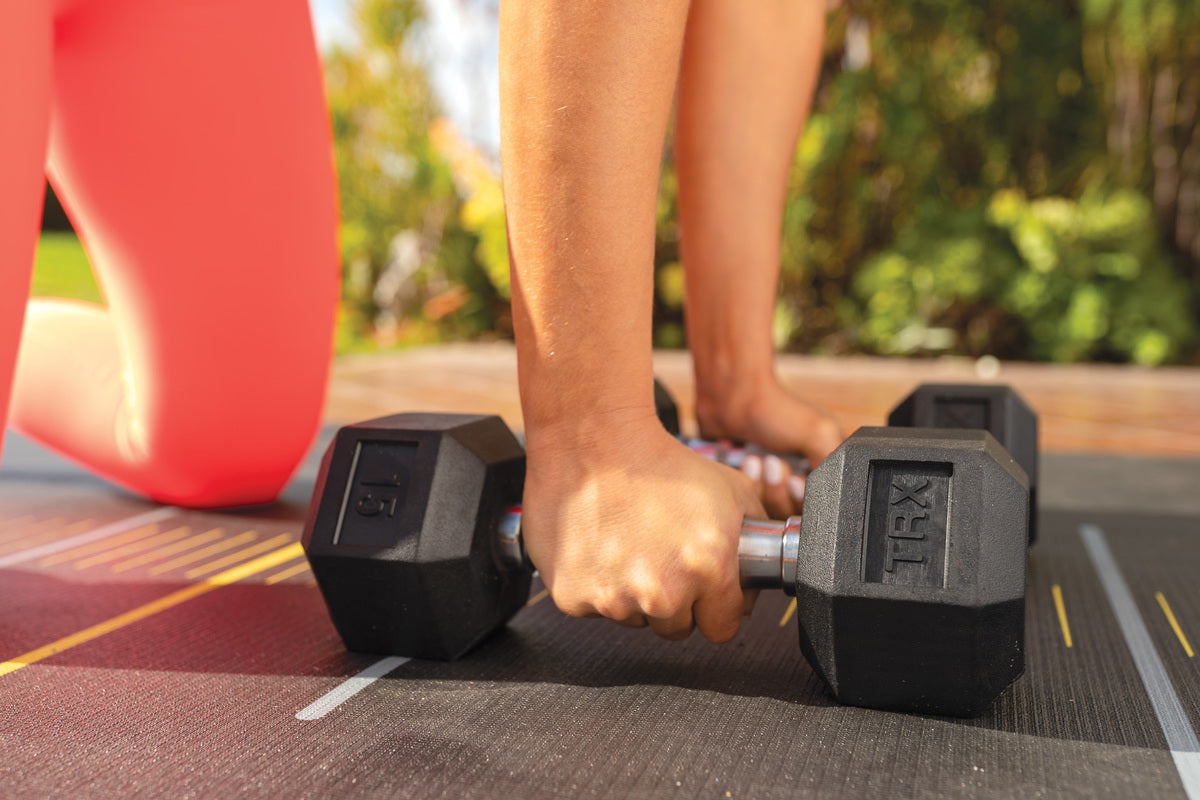If you manage a gym or studio, you understand the importance of utilizing every square foot efficiently to generate revenue. When was the last time you assessed your space to ensure it serves both you and your clients effectively?
In this blog post, we will delve into the topic of space-saving gym equipment and considerations for gym layout. Whether you're opening a new studio space or planning a significant remodel for your club, we'll provide valuable insights to help you make the most out of your available space.
5 Considerations for Improving Your Gym Floor Layout
Here are five gym layout considerations for your new studio build or club remodel.
1. Member Demographics
What type of membership does your club or studio cater to? What kind of programming are they looking for? Whether you own a franchised membership club or a boutique fitness club, you still have a common goal: being profitable while serving your clients.
It’s vital to meet consumers where they are. And with home gyms becoming more common since the start of the pandemic, clubs and studios need to find new ways to engage clients who still prefer working out from home. For clubs and studios, this means offering a hybrid approach to workout regimens that includes in-studio workouts, outdoor training, and digital workouts, according to the 2021 IHRSA report The Next Fitness Consumer.
Offering more variety in your fitness programming in both format and workout styles is vital. Even before the pandemic, clubs and studios were seeing these general trends in workout preferences:
- 15% increased usage of free online workouts
- 13% increased use of at-home fitness equipment
- 8% increased use of other digital exercise programs
- 7% increased participation in outdoor exercise
It’s clear from this report that today’s fitness consumer is not only looking for more versatility but also taking charge of their fitness needs. To keep up with fitness consumers, you need to provide more online and digital solutions that clients can use in-studio, at home, and on the go.
2. Under-Utilized Space
If clients are lining up to use the cardio or strength training equipment while ignoring your kickboxing equipment, it might be a sign that you need to repurpose that space in your gym layout. If you have room in your club or studio that’s under-utilized, then you’re losing money.
Your goal is to optimize your space to generate ROI. That might mean creating dedicated areas for large and small group fitness classes or one-on-one training. Another option is to re-evaluate if your equipment is used enough to justify the space it takes up in your studio space. When possible, try to implement multiple types of programming in your studio to get the most ROI for the area and equipment you have on hand.
Better yet, if you can provide space-saving gym equipment that fits multiple training modalities for full-body workouts, you’ll have an ideal workout space for individual training, one-on-one training with coaches, or group fitness classes.
3. Storage Space
Regardless of the types of classes and workout modalities offered, one of the biggest mistakes health club owners make when designing their gym layout is not building enough storage space. If your studio provides dumbbells, kettlebells, med balls, or other traditional strength training equipment, you need to find a convenient way to store it when not in use to not clutter up your floor space.
Standard storage options include industrial shelving units or weight racks for dumbbells and kettlebells. Lighter equipment like resistance bands, gliders, or workout mats can be stored in large tote boxes and placed inside large cabinets for a cleaner look. Wall space and overhead racks are great options for freeing up floor space in your gym layout and giving your clients more room to work out.
4. Sound and Acoustics
Another consideration for your gym layout is how sound and acoustics will carry throughout the space. Whether you have TVs in common areas or group classes that require loud, upbeat music, you need to consider how that sound will affect others working out in your studio.
If your studio is large enough to have multiple group workout spaces, one way to address this issue is to separate the classes based on the tempo of the workout. For example, you might want to put yoga classes on opposite sides of the building from spin or HIIT classes.
However, if your club is a smaller, boutique space, you may have to address sound and acoustics more creatively. For example, you could use double walls or add acoustic panels to the walls and ceilings to absorb sound from your functional fitness classes. Another option is to use rubber floor mats or other performance flooring designed to reduce noise from free weights hitting the floor during HIRT class.
5. Lighting
Playing on interior design fundamentals, using light paint colors for your walls and ceiling, bright lighting, and — when possible — natural lighting can go a long way in making your gym layout appear larger and more inviting. LED lights can offer a lot of flexibility for your studio’s ambiance, especially if it’s a multi-use space. Using recessed lights and backlighting can add more depth to your studio. And large mirrors can help to reflect natural light and make the area seem bigger.
Space-Saving Fitness Equipment for Your Club or Studio
Achieving an optimal gym layout requires finding the right balance between functional training, cardio, and strength equipment to ensure your members can maximize the benefits of your facility. Additionally, equipping your club or studio with space-saving gym equipment that caters to multiple training modalities will create an ideal workout space suitable for individual training, one-on-one sessions, or group training
YBells
From the original YBell Neo Series to our newest lines — YBell Pro Series and YBell Arc Series — YBells are the perfect compact space-saving gym equipment for maximizing the footprint of your club or studio. Its intuitive design makes it ideal for individual strength training, indoor and outdoor group fitness classes, or one-on-one training with a coach.
The YBell is a dumbbell, kettlebell, double-grip medicine ball, and push-up stand all in one. It’s compact, portable, and designed for Every Body. The YBell’s 4-in-1, award-winning design not only reduces the need for multiple pieces of equipment but also increases the ROI of your studio space by reducing the amount of storage space needed. And, it’s versatile enough to be used for full-body functional fitness, HIIT, cardio workouts, mobility exercises, strength training, core workouts, and so much more.
YBell Arc Series
The YBell Arc Series is our lightest line of YBells that range from 2.4 lb / 1.1 kg to 5.5 lb / 2.5 kg. They have the same 4-in-1 functionality as the multi-award-winning YBell Neo and are the ideal solution for those just starting their fitness journey. They’re also perfect for clubs and studios that offer classes in boxing, Tabata, Pilates, yoga, barre, and other low-impact exercises. The Arc Series is also outstanding for anyone working on injury rehab or grip strength training.
YBell Neo Series
The YBell Neo Series is our original series with weights ranging from 10 lb / 4.5 kg to 27 lb / 12 kg. With its award-winning, multi-handle design, a grip change is an equipment change with the YBell. It easily allows you to transition between a dumbbell, kettlebell, double-grip med ball, and push-up stand exercises, offering users a full-body workout that can target any number of muscle groups.
This space-saving gym equipment is made for compound movements, so they’re perfect for clubs and studios offering HIIT training, high-intensity resistance training, functional fitness, and mobility training.
YBell Pro Series
The YBell Pro Series was designed to endure the harshest conditions from the most demanding users, with weights ranging from 31 lb / 14 kg to 44 lb / 20 kg. The Pro Series is the chosen solution for increasing strength and power without sacrificing functionality. If your club or studio caters to strength training, weightlifting, high-intensity resistance training, tactical training, or basic military training, you’ll want to have YBell Pros on hand.
TRX Training Online Workouts
Keeping in trend with the increased use of online workouts, the TRX Training Club offers introductory workouts to help your clients understand how to use your bodyweight to build muscle. There are also beginner, intermediate, and advanced workouts for every stage of your client’s fitness journey.
YBell Racks
If you’re looking for easy and accessible storage for your functional fitness equipment, look no further than the YBell Vertical Rack. It’s easy to assemble and holds up to 10 YBell Neos or YBell Arcs of any size, making it a great piece of space-saving gym equipment for your club or studio. It’s perfect for keeping your workout space organized and your gear safe and secure.
New Horizontal Storage Racks for use with all YBell products, including the YBell Pro Series, will be coming soon.
FITBENCH
The FITBENCH is space-saving gym equipment at its finest for clubs and studios of any size. FITBENCH was created to solve a problem experienced by almost every club or studio using traditional strength training equipment in high-intensity classes. The benches come fully loaded with commercial-grade weights and functional workout equipment, making any FITBENCH the perfect choice for class environments and small group training in your club or studio, or for your outdoor classes.
YBell Fitness and FITBENCH have also teamed up to bring you the FITBENCH YBell Combo, which comes with the 8-position incline bench with a padded top, 3 separate pairs of snap-proof, nylon-covered FITBANDS, and the entire YBell Neo Series.
While today’s fitness consumer is looking for more variety in modality and format, the overall desire to work out in clubs and studios hasn’t declined. Focus on how your workout space complements or improves consumers’ home workout experience. And as your club begins to analyze how to maximize your space, don’t forget to speak to members to ensure that you’re making updates with their preferences in mind.



